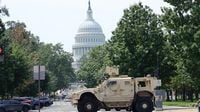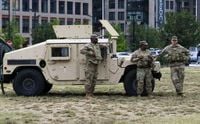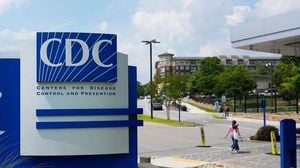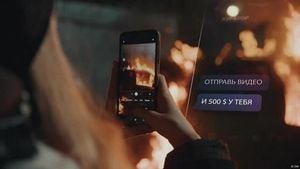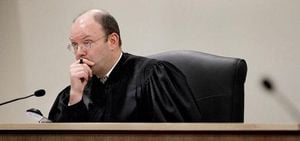On the morning of August 20, 2025, the usually quiet streets of Capitol Hill in Washington, D.C. were jolted awake by the thunderous sound of metal colliding. A massive National Guard mine-resistant ambush protected all-terrain vehicle (MATV), weighing up to 16 tons and designed to withstand explosive attacks, crashed into a civilian car at the intersection of 8th Street SE and North Carolina Avenue. The incident, which unfolded shortly after 6 a.m., left one civilian trapped inside their silver SUV, requiring emergency responders to extricate the individual before transporting them to a hospital with minor injuries. Fortunately, according to police and D.C. Fire Department spokesperson Vito Maggiolo, the injuries were not life-threatening.
As reported by NPR, the MATV was part of a five-vehicle convoy of D.C. National Guard vehicles moving through the neighborhood as part of a larger deployment ordered by President Donald Trump. The deployment, known as the D.C. Safe and Beautiful Task Force, has seen hundreds of National Guard troops—many from outside the District—stationed across Washington to address what the administration has called a “crime emergency.” The National Guard confirmed that the matter is under investigation, emphasizing in a statement to Fox News Digital, “The D.C. National Guard and (Joint Task Force-DC) remains committed to the safety of our service members and the public.”
The crash scene quickly drew attention from local residents and bystanders. A video circulating on social media captured the aftermath: the tan-colored armored vehicle, towering over the crushed side of the civilian car, and a woman’s voice ringing out, “You come to our city and this is what you do? Seriously?” The sense of unease was palpable. Samuel Pastore, a neighborhood commissioner who lives nearby, didn’t mince words in his criticism of the heavy military presence: “Our kids are getting back to school. Get these tanks out of our streets!”
While the incident itself was not considered a criminal offense—prompting the Metropolitan Police Department to forgo releasing a formal report, according to spokesperson Michael Russo—it has become emblematic of the tensions simmering in the capital. The deployment of military vehicles and troops was ordered by President Trump as part of a sweeping crackdown on crime. On August 11, Trump announced the mobilization of 800 D.C. National Guard troops and federalized the Metropolitan Police Department, aiming to “make DC safe and beautiful,” as the White House put it in a statement to Fox News Digital. The White House further explained, “National Guard troops will protect federal assets, provide a ‘safe environment’ for law enforcement officials and provide a visible presence to deter crime.”
But the presence of these troops is not limited to those from the District. According to The Guardian and other outlets, six Republican-led states—Louisiana, Mississippi, Tennessee, Ohio, South Carolina, and West Virginia—have pledged to send at least 1,200 National Guard troops to Washington. More than half of the 1,900 troops currently deployed in the city hail from these states, responding to direct requests from Trump administration officials. Fox News Digital reported that approximately 1,300 National Guard troops from these states had already arrived in the capital as of August 20.
The National Guard’s role, as outlined by the White House, is multifaceted: protecting federal buildings, providing backup to law enforcement, and serving as a visible deterrent to would-be criminals. The deployment has not been without controversy, especially given that the crime rate in Washington has reportedly been falling, according to The Guardian. Yet, the Trump administration and its allies argue that the show of force is necessary to combat what they describe as “bloodshed, bedlam, and squalor” in the nation’s capital.
Attorney General Pam Bondi, a key figure in the administration’s effort, announced on social media that “more than 550 people have been arrested so far,” since the crackdown began on August 7. She added, “Together, we will make DC safe again!” The U.S. Marshals are even offering $500 rewards for information leading to further arrests. According to a White House official cited by NPR, of those arrested, three are known gang members, and authorities have seized 76 firearms as part of their efforts.
For many residents, the sight of military vehicles like the MATV—designed for war zones and featuring a V-shaped hull to deflect roadside bombs—rolling through their neighborhoods is jarring. The vehicle involved in the crash, which Fox News Digital described as being part of a five-vehicle convoy accompanied by a D.C. Metropolitan Police cruiser, is twice the height of a standard civilian car. The video footage and images shared by outlets like Fox News Digital and The Washington Post underscore the stark contrast between the military hardware and everyday civilian life.
Despite the scale of the deployment and the high-profile nature of the crash, officials have been quick to stress that the incident was not the result of criminal behavior. The D.C. National Guard, in its statement, said, “This is currently undergoing an investigation.” The driver of the civilian car, though shaken, was conscious and breathing when extricated, and their injuries were not considered life-threatening, according to both NPR and the D.C. Fire Department.
Meanwhile, the debate over the militarization of Washington’s streets continues. Critics like Samuel Pastore argue that the heavy-handed approach is both unnecessary and disruptive, especially as children return to school and daily routines resume. Supporters of the deployment, including President Trump and Attorney General Bondi, maintain that the measures are essential to restoring order and ensuring public safety.
As the investigation into the crash proceeds, the broader questions about the balance between security and civil life in the nation’s capital remain unresolved. The presence of armored vehicles and out-of-state troops is a visible reminder of the extraordinary measures being taken in Washington, and the incident at 8th Street and North Carolina Avenue SE has only intensified the debate.
For now, the streets of Capitol Hill bear the marks—literal and figurative—of a city caught between the imperatives of security and the rhythms of everyday life. The aftermath of the crash serves as a potent symbol of the challenges facing Washington as it navigates a period of heightened tension and unprecedented federal intervention.
